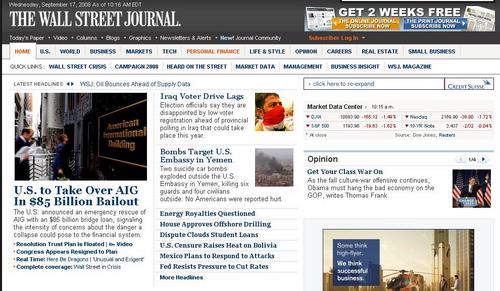Philip Meyer, whose 2004 book The Vanishing Newspaper: Saving Journalism in the Information Age, is often credited as being the first to predict the newspaper industry’s demise, writes in American Journalism Review of the dwindling options available to newspaper owners. In a superbly readable essay, Meyer frames the industry’s plight in historical contexts ranging from Gutenberg’s displacement of town criers to the opportunities modern agriculture created for packaged food makers. At the heart of the problem is one statistic we hadn’t seen before: “Classified ads moved from 18 percent of newspaper advertising revenue in 1950 to 40 percent in 2000.” Craig Newmark came along and poof! There are plenty of other Craig Newmarks out there waiting their turns, Meyer writes, ominously.
The good news is that there’s precedent for these problems. Meyer suggests that the saving grace for newspapers – and probably the only one they have left – is community influence. That’s where local news organizations enjoy a level of trust that online wannabes can’t approach. But by community, “I don’t mean stenographic coverage of public meetings, channeling press releases or listing unanalyzed collections of facts,” Meyer writes. It means contextual reporting that delivers useful and actionable advice. Medium is unimportant, as is frequency. Meyer infers that the seven-day-a-week mandate is a liability in a time of fluid and inexpensive information. Discerning readers will pay for information that speaks to their specific interests, he proposes, but newspapers have got to start by rejecting their all-things-to-all-people philosophy.
Tribune Co.: One Big Litigious Family
A group of current and former Tribune Co. employees has filed a class action suit against CEO Sam Zell, questioning the tactics Zell used to acquired Tribune Co. in a highly leveraged deal, his administration of the employee stock option plan, his decisions regarding layoffs and other operational issues. The plaintiffs include one current Tribune employee – Los Angeles Times auto critic Dan Neil – and five former employees, all journalists. They’re represented by noted class-action lawyers Joseph Cotchett and Philip Gregory. In a statement, Zell called the suit “frivolous and unfounded.” In an e-mail to employees, he lamented the plaintiffs’ decision to air dirty laundry in public and concluded, “We are partners. We need to act like it.” Tell Zell characteristically minces no words in attacking the boss: “We have no power. We have no say. We have never been consulted in a single action that you or any of your cronies have taken in dismantling the Tribune Co. So stop f*****g call me your partner.” Guess who won’t be sharing a table at the company picnic.
Layoff Log
- The St. Louis Post-Dispatch has laid off between 17 and 20 people, depending on which account you read. The situation is particularly unpleasant in the Gateway City because the cuts come during talks with the Newspaper Guild about an extension to the current union contract. In fact, the Guild walked away from the bargaining table, charging that newspaper management and consistently pushed ahead the timeframe for the layoffs as a bargaining tactic. Among the victims is Patrick M. O’Connell, the newspaper’s primary crime reporter.
- The bloodletting may not be over at The McClatchy Co. CEO Gary Pruitt was quoted last week saying, “It may get worse before it gets better.” McClatchy is still reeling from the $2 billion in debt it took on to finance the 2006 acquisition of Knight-Ridder, a deal that still has questionable long-term value. “It’s hard to claim it’s a good deal when you see the stock performance,” Pruitt said. McClatchy has already cut its workforce by 20% and halved its shareholder dividend. McClatchy Watch has the details.
- Tulsa World posts a note to readers about consolidating Sunday sections that presages staff cuts. It notes that the staff has been working “to conserve news space and reduce the overall page count of the newspaper by writing shorter stories,” and that, “We are proud of the fact that we have the largest news staff of any media in our area.” Prior experience would indicate that a large staff and a shrinking news hole don’t coexist nicely. Check out the comments on the story, which mostly rip the paper for cutting back on space.
Miscellany
Valleywag observes that the combined wealth of Google’s co-founders now exceeds the value of the entire US newspaper industry. Larry Page and Sergey Brin are now worth $16 billion each, compared to the $20 billion valuation Wall Street assigns to newspapers and their subsidiaries, including test prep and broadcasting businesses.
And Finally…
Our Google Alert filter caught John McIntyre in its webbing this week, and we quickly added him to our RSS reader. McIntyre is director of the copy desk at the Baltimore Sun and a former president of the American Copy Editors Society {note: “Editors” is not possessive). His meticulously edited blog features such gems as a recent entry on the mechanics of courtesy titles such as “Mr.” and “Professor” – did you know that incarcerated criminals aren’t entitled to be called “Mr.” but may regain the title once probation has expired? -and a clever paragraph on last week’s National Punctuation Day that consists of a single sentence in which McIntyre uses all 13 forms of punctuation. Newspaper editors know that nothing elicits more reader comment than issues of spelling, punctuation and usage; ergo, McIntyre has his fingers on the pulse of the readers.

![John McIntyre McIntyre [cq]](http://www.newspaperdeathwatch.com/wp-content/uploads/2008/09/mcintyre.jpg)









